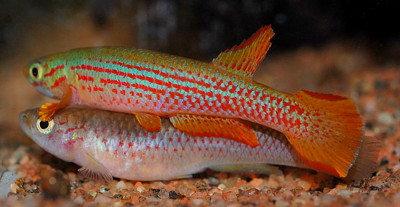Aphyosemion wildekampi Berkenkamp 1973

JVC 08 Gouekamg
Photo courtesy of Karsten Keibel
| Meaning of Name |
After Rudolf Hans Wildekamp.(Ruud). |
|||
| First Description |
Berkenkamp H.O. 1973. Beschreibung eines neuen Prachtkärpflings aus Ost-Kamerun, Aphyosemion wildekampi spec. nov. Aquarienfreund 2 (7): p 113-119, figures 3 &
4. |
|||
| Size |
4.5 cm. |
|||
| Meristics |
|
|||
| Karyotype |
n = 15, A = 18 ( Scheel 1975) |
|||
| Sub-Genus |
Aphyosemion |
|||
| Group |
elegans |
|||
| Synonyms |
|
|||
Populations
|
http://www.nakashima.org/gaphyosemion_wildekampi.htm Japan Gallery |
|||
| Type Locality |
Berkenkamp's original description of the type
locality is incorrect (Wildekamp 1993). Vlaming (1988), the original
collector states they were caught immediately east of Bertoua, along
a road to the airport in a brook). |
|||
| Distribution |
South eastern Cameroon, south western African Republic & Northern Congo (Brazzaville). The area is on the frontier of forest & savannah dividing the ranges of A.elberti & A.exiguum. |
|||
| Habitat |
Water quality at a point 40 km west of Bertoua measured pH 7, DH 0·01, water temperature 22-24°C. In the dry season these measurements changed to pH 5·2, DH 0·03, water temperature 28°C. Sympatric sp. include Aphyosemion elberti. Vlaming noted that at the time of the original collection the biotope was shaded by forest cover. The biotope was a 'plantless creek, but with emerse vegetation' & A.wildekampi was very abundant whilst A.elberti were few in number. Another collecting trip in 1971 found the forest cut back to expose the biotope to more sunlight. This had an effect on the fish stocks where A.wildekampi was less frequent than the more abundant A.elberti. |
|||
| Distinguishing Characteristics | ||||
| Colour/Pattern Variability | Low, although northern populations exhibit few red spots on the body whereas southern populations tend to have more red spots. | |||
| History |
First collected by Mr. P.J.Vlamink who brought them to Holland in November 1971.When they first entered Holland they were distributed as Aphyosemion K4. The 'K' stood for Kameroen (the Dutch spelling for Kameroen) & the '4' referred to the 4th collecting locality. Other sp. brought in by Vlamink were A.bualanum (now elberti) Red form, A.cameronense, A.batesii, Barbus jae, Ctenopoma ansorgei, Phago maculatus & E.sangmelinensis which were received by Mr.B.J.Schrieken of Den Helder. Wildekamp received some of these K4 fish & sent a preserved trio to Berkenkamp in April 1973 who described them as Aphyosemion wildekampi in honour of Wildekamp. Grell & Kohler collected at locations GKCAR 90/6 & 7. in 1990. |
|||
| Breeding Notes |
Berkenkamp mentioned in K/N 104 that in nature there breeding season was probably March, preceeding the dry season. This sp. seems difficult to breed. Reports suggest
that eggs are laid in peat fibre & hatch after 10-15 days in water
incubation. Ralf Fredrich in BKA Newsletter No. 318 (March
1992) bred the Bertoua population in water of pH 7, GH 10-12°, water
temperature 21°C. The sexes were seperated & conditioned on
live foods for 2 weeks. A trio were put in a 12 litre tank with the
bottom covered in a layer of peat fibre. A nylon mop was added which
was the preferred spawning site. Sawning yielded 20 eggs in a week.
At temperatures above 22°C the fish stopped spawning. Edd Kray in BKA newsletter No.369, June 1996 reported sexing the young out in 3-4 months. Sex ratio was biased towards males (90%). |
|||
| Diameter of Egg | 1.1 mm. | |||
| Remarks |
|